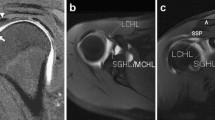Abstract
Objective
To try to define an association between clinical history and the finding of isolated teres minor denervation on routine magnetic resonance (MR) examination of the shoulder.
Design
A retrospective review of all shoulder MR examinations performed at our institution over a 2-year period (n=2,563)
Patients
All patients and MR examinations demonstrating isolated denervation of the teres minor muscle as determined by review of this subset of patients (n=61)
Results
A 3% incidence of isolated teres minor denervation was found. No patient had a clinical history concerning the classic quadrilateral space syndrome, and no patient had a structural lesion in the quadrilateral space.
Conclusions
Isolated teres minor denervation is not an uncommon finding on routine shoulder MR imaging and may be associated with pathology other than a structural lesion in and about the axillary neurovascular structures, such as rotator cuff injuries and traction injury on the axillary nerve sustained during a glenohumeral joint translational event.



Similar content being viewed by others
References
Linker CS, Helms CA, Fritz RC. Quadrilateral space syndrome: findings at MR imaging. Radiology 1993; 188:675–676
Cahill BR, Palmer RE. Quadrilateral space syndrome. J Hand Surg 1983; 8:65–69
Chautems RC, Glauser T, Waeber-Fey MC, Rostan O, Barraud GE. Quadrilateral space syndrome: case report and review of the literature. Ann Vasc Surg 2000; 14:673–676
Lester B, Jeong GK, Weiland AJ, Wickiewicz TL. Quadrilateral space syndrome: diagnosis, pathology and treatment. Am J Orthop 1999; 28(12): 718–725
Fleckenstein JL, Watumull D, Conner KE, Ezaki M, Greenlee Jr RG, Bryan WW, Chason DP, Parkey RW, Peshock RM, Purdy PD. Denervated human skeletal muscle: MR imaging evaluation. Radiology 1993; 187:213–218
Uetani M, Hayashi K, Matsunaga N, Imamura K, Ito N. Denervated skeletal muscle: MR imaging; work in progress. Radiology 1993; 189:511–515
McIlveen SJ, Duralde XA, D’Alessandro DF, Bigliani LU. Isolated nerve injuries about the shoulder. Clin Orthop 1994; 306:54–63
Perlmutter GS. Axillary nerve injury. Clin Orthop 1999; 368:28–36
Zhao X, Hung LK, Zhang GM, Lao J. Applied anatomy of the axillary nerve for selective neurotization of the deltoid muscle. Clin Orthop 2001; 390:244–251
Bryan WJ, Schauder K, Tullos HS. The axillary nerve and its relationship to common sports medicine procedures. Am J Sports Med 1986; 14(2):113–116
Francel TJ, Dellon AL, Campbell JN. Quadrilateral space syndrome: diagnosis and operative decompression technique. Plastic Recon Surg 1991; 87(5):911–916
Gitlin G. Concerning the gangliform enlargement (“pseudoganglion”) of the nerve to the teres minor muscle. J Anat 1957; 57:466–470
Hashimoto T, Hamada T, Nakamura T, Sasaguiri Y, Suzuki K. Myxoid and globular degeneration of nerves in the shoulder joint. Clin Orthop 1995; 320:55–64
Bredella MA, Tirman PFJ, Fritz RC, Wischer TK, Stork A, Genant HK. Denervation syndromes of the shoulder girdle: MR imaging with electrophysiologic correlation. Skeletal Radiol 1999; 28:567–572
Author information
Authors and Affiliations
Corresponding author
Rights and permissions
About this article
Cite this article
Sofka, C.M., Lin, J., Feinberg, J. et al. Teres minor denervation on routine magnetic resonance imaging of the shoulder. Skeletal Radiol 33, 514–518 (2004). https://doi.org/10.1007/s00256-004-0809-3
Received:
Revised:
Accepted:
Published:
Issue Date:
DOI: https://doi.org/10.1007/s00256-004-0809-3




